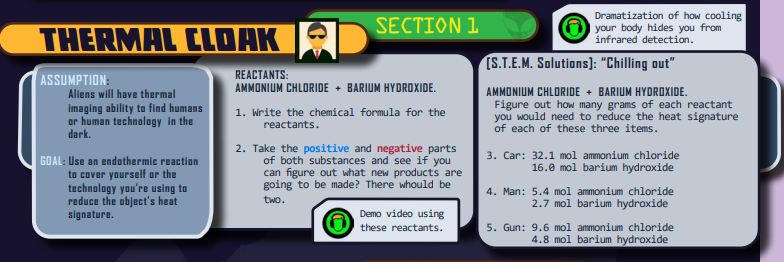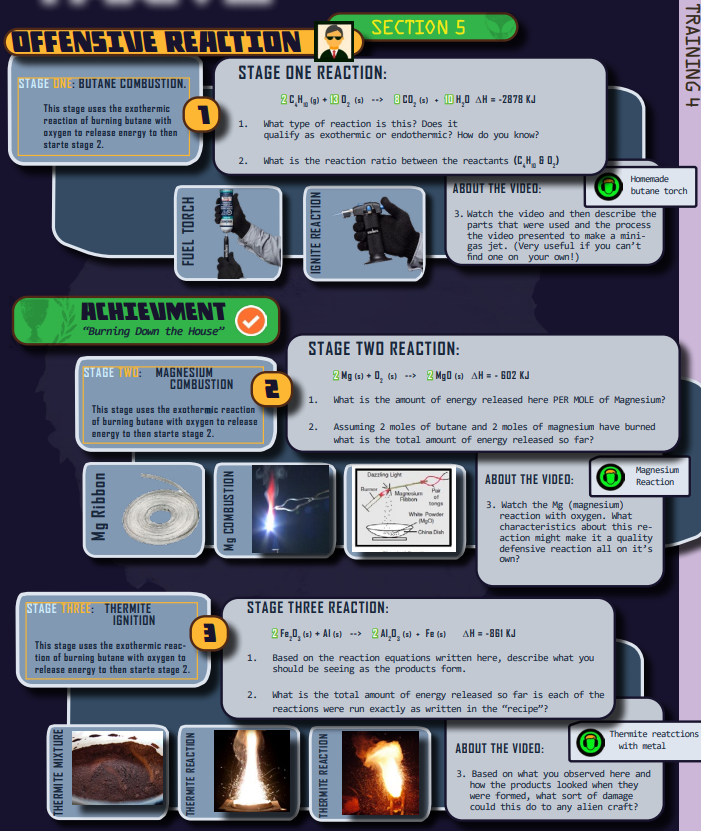Training FOUR Guide
Section ONE: (Est. Time = 15 min)
Chemistry defense tactic: THERMAL CLOAK
A “Director’s Briefing icon” provides the meaning and the tools to make the section possible. Mole and gram to mole calculations can be tricky. Watch this first.
The section contextualizes practical application of finding the right amount of reactant to “measure out” because scales do not measure moles. The example itself is a little extrapolated, but the math is legit.
The green media Icons provide video instructions on how to do examples of these calculations. Color codes have been provided so that students can make more sense of how elements are rearranged to make new chemical compounds.
Answers to Section 1 Questions:
- Chemical formulas for ammonium chloride = NH4Cl
Chemical formula for barium hydroxide = Ba(OH)2
— - The positive ions would be the Ba2+- and the NH4. The negative parts of the compounds would be OH– and Cl–
If the positives and negative elements are rearranged, the new pairs would be BaCl2 and NH4OH.
— 32.1 mol of ammonium chloride = 1720 g / 16.0 mol barium hydroxide = 2740 g.
—5.4 mol of ammonium chloride = 290 g / 2.7 mol barium hydroxide = 463 g
—9.6 mol ammonium chloride = 513 g / 4.8 mol of barium hydroxide = 822 g
Section TWO: (Est. Time = 15 min)
Chemistry defense tactic: GLOW IN THE DARK
A “Director’s Briefing icon” provides the meaning and the tools to make the section possible. This section involves using online inspiration to design a mechanism that could help tag alien tech so we can see them for a while once the sun goes down.
While the visible tagging may not last for long in the visible spectrum, it’s a way to be able to tag alien tech, even while cloaked, so we can see them move in the dark. This is a phosphorescent reaction. It’s product is light itself!
The green media Icons shows a video that describes glow in the dark phosphorescent works.
Answers to Section 1 Questions:
- Step one is to simply search the phrase “How does glow in the dark paint work?” They can write down the definition if so desired.
— The video states that energy (chemical, photon, or heat) excite electrons into higher energy states. When the electrons return to the original state the light is released. Chemicals called “Phosphors” like strontium aluminate and zinc sulfide capture the light energy and let it go over a longer period of time.
—Designs provided by the students should be cleanly drawn, labeled with parts of their “launching” device clearly drawn (ideally with at least two different elevations, but that’s up to the individual instructor). Students should also be able to verbally provide a description on how the device is loaded and how they know it will cover the required 100 ft distance.
Section THREE: (Est. Time = 20 min)
Chemistry defense tactic: SMOKE SCREEN
This is a complicated reaction and even the one provided has some debate over the correctness of the balanced equation. The “Director’s Briefing icon” provides information on this section as well as additional data on how to read this chemical sentence or recipe as it’s often called.
The goal here (for the simulation) is to get familiar with a chemical reaction that could be used to evade visual detection. The chemistry learning goal focuses (again) on the chemical reaction equation, the coefficients, and molar ratios.
The green media Icons provide YouTube recorded examples of actual smoke screen reactions from chemists around different parts of the world. The last icon demonstrates just how to read the reaction ratios and what they mean to a chemist.
Answers to Section 1 Questions:
- The reactants are called, Potassium Nitrate and Sucrose (table sugar).
— - The molar ratio between sugar and moles of water is 5:55 (this is, eh, OK… but it should be reduced to 1:11)
— - The ratio of potassium nitrate to the sugar is 48:5 (as this cannot be reduced into whole numbers the ratio is OK as is.)
— - 60 grams of potassium nitrate (divided by the molar mass of potassium nitrate) is 0.59 or 0.6 mol. 40 grams of sucrose (divided by the molar mass of sucrose) is 0.12 moles. 0.6:0.11 (divided) would be approximately 5 moles of potassium nitrate to every one mole of sucrose. The chemical equation is 48:5 or 9.6 moles of potassium nitrate to one mole of sugar. These ratios are not the same.
Section FOUR: (Est. Time = 20 min)
Chemistry defense tactic: MELT EVERYTHING
Without question, this is the most hostile of the defensive actions. The thermite reaction is not to be trifled with.The “Director’s Briefing icon” talks about this as well as what to do in the section.
This section focuses on the thermal output of the reaction, which is substantial. Heat is also a product of the reaction and also follows all of the rules connected with reaction ratios.
The green media Icons are nothing but visual eye candy given in a store of pure mayhem. Watch and enjoy.
Answers to Section 1 Questions:
- According to the reaction or “recipe” each time the reaction is run it produces -861 KJ. The reaction uses 2 mols to do this. What if there were 5 used. More heat would be produced. Too calculate, multiply 5/2 by the -861 KJ. = 2153 KJ
— - If the device we built only used half a mole of iron and one mole of Al metal, this would essentially be “halfing the recipe”. So take half of the heat released. 430.5 KJ would be emitted.
Section FIVE: (Est. Time = 20 min)
Chemistry defense tactic: Steps for ignition.
This sections describes the thermo-chemical build up of system energy that eventually leads to the ignition of the thermite reaction. The “Director’s Briefing icon” provides information on this section as well as additional data on how to understand the key points of the section.
Each stage uses an exothermic reaction to build the system’s energy a little higher. The activation energy of the thermite reaction is VERY high and requires an enormous investment of kinetic energy to get the molecules moving fast enough so they can react.
The green media Icons provide videos that give more in-depth information about each section. NOTE: Depending on the student population some of these might be skipped because they WILL try this at home. Someone will.
Answers to Section 1 Questions:
- This is a exothermic reaction – evidence for this is due to the negative sign next to the number at the end of the equation.
—
The reaction ratio between butane and oxygen is 2:13
—
The parts include a bike pump needle, a syringe, there is some IV tubing, hot glue, and an IV valve that turns gas flow on and off.
— - The reaction says there are 2 mols of Mg here. So per mol would be half of the displayed value. E = -301 KJ
—
Basically if the first reaction ran once (2 mols Mg used) and the second reaction here ran once (2 mol Mg) then just add the quantities of heat produced from each reaction together. E = -3480KJ
—
The answers might vary, but the reaction is very bright and could temporarily blind attackers or sensor equipment.
— - The products that should be forming (on the right hand side of the reaction equations) should be Aluminum Oxide and pure Iron metal… AND -861 KJ of heat.




